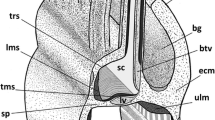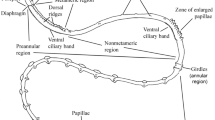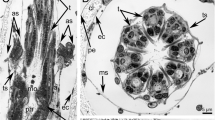Summary
The developmental stages of the colloblasts ofPleurobrachia pileus which are located in the “tentacle root” were studied in detail by electron microscopy, and the origin of the various parts which comprise the mature colloblast was analyzed. In addition to a revised version of the mature colloblast the successive stages of its differentiation are described.
The so-called “Klebkörnchen”, which are extra-cellular electron dense granules, do not originate from the colloblasts themselves but from special cap cells (Kappenzellen). Hitherto it was suggested that the intra-cellular p-bodies which are globular particles located at the periphery of the head portion of the cell were the precursor stages of the extracellular Klebkörnchen. The present observations on colloblast development are not in favour of this assumption.
The spiral filament which is a highly modified cilium develops from a “basal body equivalent”. A “root organelle” develops from the proximal end of the spiral filament, and at the distal end which lies in the center of the head portion of the colloblast grows the “spheroidal body”. The cone-shaped root organelle with its periodic striation seems to be homologous to a ciliary rootlet. As a special feature, this rootlet bears several hundreds of fine filaments which terminate at the plasma membrane. The spheroidal body and the fibrous tracts are formed out of amorphous material assembled at the distal end of the naked axoneme.
The spheroidal body is the most complexe structure ever seen in association with the tip of a ciliary axoneme. In conclusion, the whole apparatus, the spiral filament with the broad membraneous lamellae and its associated structures, i.e. the root organelle and the spheroidal body, is the most highly modified cilium described so far.
Zusammenfassung
Die Entwicklungsstadien der Colloblasten vonPleurobrachia pileus wurden elektronenmikroskopisch untersucht. Bildungsort ist die „Tentakelwurzel”. Ausgehend von einer ergÄnzten und korrigierten Darstellung der fertigen Klebzelle wird die Herkunft und Differenzierung der au\ergewöhnlichen Zellbestandteile beschrieben.
Die sog. „Klebkörnchen“, extrazellulÄr liegende osmiophile Tropfen, stammen nicht von den Colloblasten selbst, sondern von besonderen Kappenzellen. Bisher wurde meistens angenommen, da\ die intrazellulÄren P-Körper (globulÄre Partikel an der Peripherie des Kopfteils der Zelle) Sekretvorstufen der extrazellulÄren Klebkörner seien. WÄhrend der Zelldifferenzierung ist dies nach den vorliegenden Beobachtungen nicht der Fall.
Das Spiralfilament — eine stark abgewandelte Cilie — entwickelt sich aus einem „Basalkörper-Äquivalent“. Am basalen Ende des Spiralfilaments entsteht das „Wurzelorganell“, am distalen, im Zentrum des Kopfteils der Zelle liegenden Ende der Sphaeroidalkörper. Das zapfenförmige, quergestreifte Wurzelorganell dürfte der Wurzelfaser einer Cilie homolog sein. Als eine bei Wurzelfasern bisher noch nicht beobachtete Besonderheit trÄgt es jedoch Hunderte von feinen, mit ihren Enden an der Zellmembran ansetzenden Fibrillen. Der Sphaeroidalkörper, mitsamt den VerbindungsstrÄngen zu den P-Körpern, entsteht durch Anlagerung von amorphem Material an der von einer Membranbedeckung freien Spitze des „Axonems“.
Bei dem Sphaeroidalkörper dürfte es sich um das erste Beispiel einer umfangreichen Struktur am distalen Ende eines Axonems handeln. — Als Gesamtsystem kann das Spiralfilament mit den ausgedehnten Lamellen seiner Hüllmembrane, mit dem basalen Wurzelorganell und dem distalen Sphaeroidalkörper als die komplizierteste aller bisher bekannt gewordenen modifizierten Cilien betrachtet werden.
Similar content being viewed by others
Literatur
Arnold, J.M.: Intercellular bridges in somatic cells: cytoplasmic continuity of blastoderm cells ofLoligo pealei. Differentation2, 335–341 (1974)
Barber, V.C.: Cilia in sense organs. In: Cilia and flagella (M.A. Sleigh, ed.), pp. 403–433. London-New York: Academic Press 1974
Bargmann, W., Jacob, K., Rast, A.: über Tentakel und Colloblasten der CtenophorePleurobrachia pileus. Z. Zellforsch.123, 121–152 (1972)
Bradbury, P.C., Trager, W.: The fine structure of the mature gametes ofHaemoproteus columbae Kruse. J. Protozool.15, 89–102 (1968a)
Bradbury, P.C., Trager, W.: The fine structure of microgametogenesis inHaemoproteus columbae Kruse. J. Protozool.15, 700–712 (1968b)
Fawcett, D.W.: Intercellular bridges. Exptl. Cell Res. Suppl.8, 174–187 (1961)
Hertwig, R.: über den Bau der Ctenophoren. Jena: Fischer 1880
Hovasse, R.: Trichocystes, corps trichocystoides, cnidocystes et colloblastes. ProtoplasmatologiaIII, F, 1–57 (1965)
Hovasse, R., de Puytorac, P.: Contributions à la connaissance du colloblaste, grâce à la microscopie électronique. C.R. Acad. Sci. Paris255, 3223–3225 (1962)
Hovasse, R., de Puytorac, P.: Le colloblaste des Cténophores: Ultrastructure, signification. Proc. XVI. Intern. Cong. Zool.1, 27 (1963)
Komai, T.: Studies on two aberrant Ctenophores,Coeloplana andGastrodes. Published by the Author, Kyoto (1922)
Longo, F.J., Anderson, E.: Gametogenesis. In: Concepts of development (J. Lash, J.R. Whittaker, eds.), pp. 3–47. Stamford, Connecticut: Sinauer Associates 1974
Phillips, D.M.: Structural variants in invertebrate sperm flagella and their relationship to motility. In: Cilia and flagella (M.A. Sleigh, ed.), pp. 379–402. London-New York: Academic Press 1974
Pitelka, D.R.: Fibrillar systems in Protozoa. In: Research in protozoology, Vol. III (T.T. Chen, ed.), pp. 279–388. Oxford: Pergamon Press 1969
Pitelka, D.R.: Basal bodies and root structures. In: Cilia and flagella (M.A. Sleigh, ed.), pp. 437–469. London-New York: Academic Press 1974
Reger, J.F.: Spermiogenesis in the spider,Pisaurina sp.: a fine structure study. J. Morphol.130, 421–434 (1970)
Satir, P.: Studies on cilia. II. Examination of the distal region of the ciliary shaft and the role of the filaments in motility. J. Cell Biol.26, 805–834 (1965)
Schneider, K.C.: Lehrbuch der vergleichenden Histologie der Tiere. Jena: Fischer 1902
Schneider, K.C.: Histologisches Praktikum der Tiere. Jena: Fischer 1908
Sleigh, M.A. (ed.): Cilia and flagella. London-New York: Academic Press 1974
Storch, V., Lehnert-Moritz, K.: Zur Entwicklung der Kolloblasten vonPleurobrachia pileus (Ctenophora). MÄr. Biol.28, 215–219 (1974)
Weill, R.: Structure, origine et interprétation cytologique des Colloblastes deLampetia pcmcerina Chun (Cténophores). C.R. Acad. Sci. Paris200, 1628–1630 (1935a)
Zetterquist, H.: The ultrastructural organization of the columnar absorbing cells of the mouse jejunum. Thesis, Dept. of Anat., Karolinska Institut, Stockholm (1956)
Author information
Authors and Affiliations
Rights and permissions
About this article
Cite this article
Benwitz, G. Elektronenmikroskopische Untersuchung der Colloblasten-Entwicklung bei der CtenophorePleurobrachia pileus (Tentaculifera, Cydippea). Zoomorphologie 89, 257–278 (1978). https://doi.org/10.1007/BF00993952
Received:
Issue Date:
DOI: https://doi.org/10.1007/BF00993952




